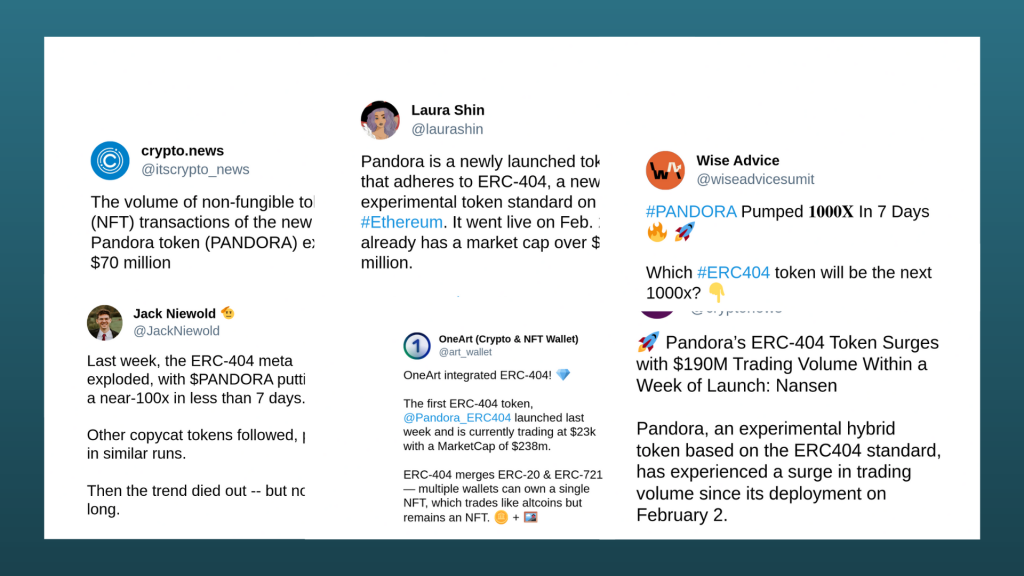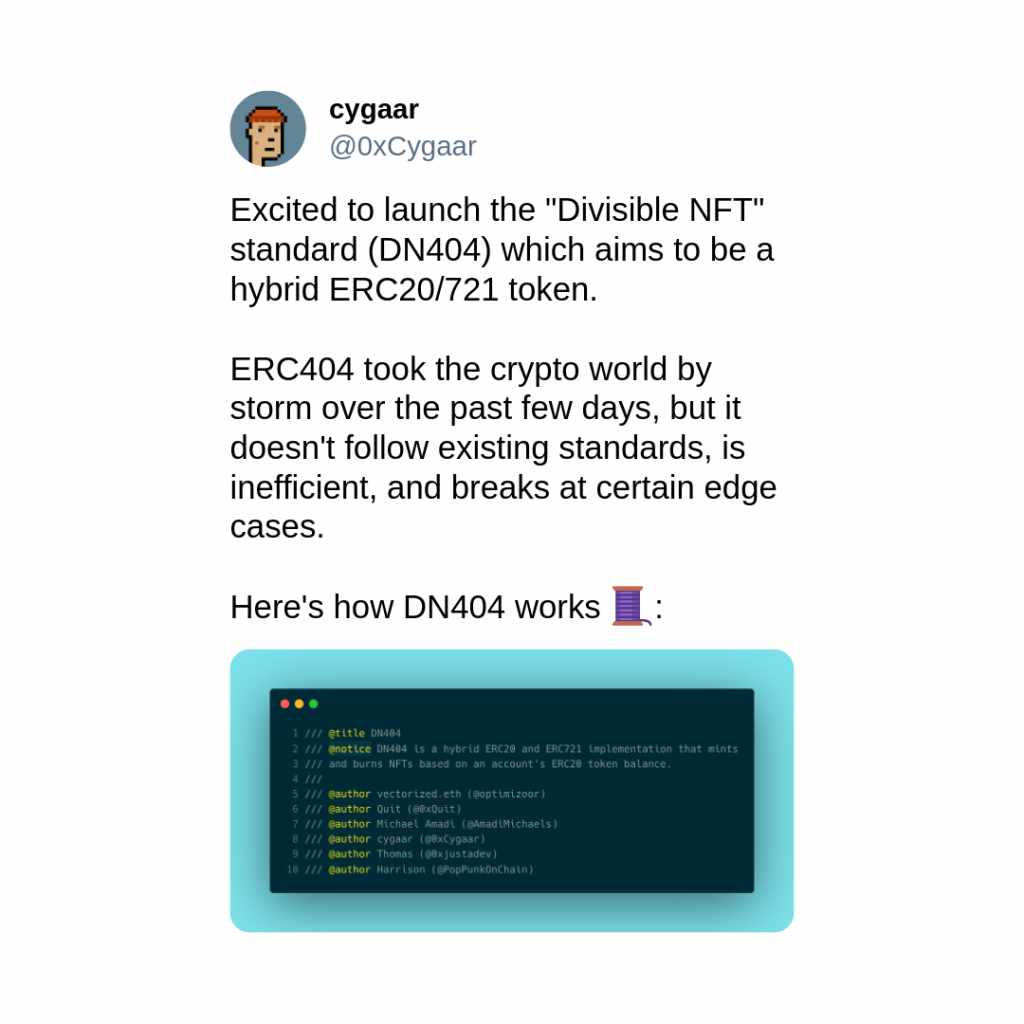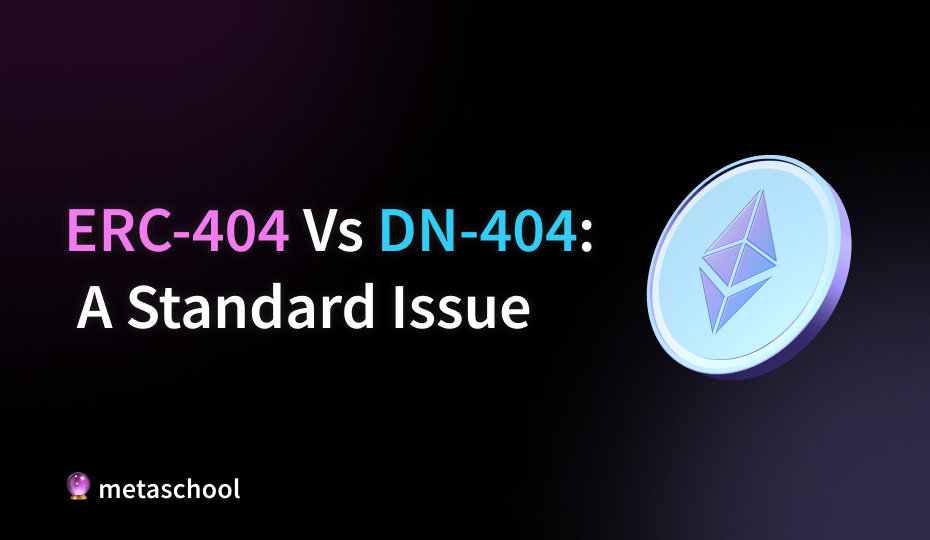Table of Contents
Surge of interest
A price surge is not that big of a deal when it comes to the crypto realm, I mean, you see coins soaring and dipping all the time. But then there are those rare instances when these surges defy all laws of gravity and climb to absurd figures like 12000%. Such events raise eyebrows, fire up laptops and get you hooked on a Twitter scrolling spree.

Pandora, one of the latest and shiniest tokens in the block, achieved this mind-boggling feat within a week of its release (Went from an initial low of $250 to $32,000). To further widen your jaw, Bitcoin was able to hit the $30,000 mark, 12 years after its release!
So, what’s so special about this new Pandora token that it was able to achieve so much in such a short time? Well, it all boils down to a new “Experimental” Token standard called ERC-404!
🔥 Check this course out: Write an Elon Musk NFT Smart Contract on OpenSea
ERC-404: Explanation Not Found
In the Ethereum blockchain universe (EBU), we’ve got two main token standards: ERC-20s and ERC-721s (NFTs). ERC-20 tokens are like your everyday currency – think of them as dollars in your digital wallet. They’re interchangeable, with one token always equal in value to another of the same kind. Then there are NFTs, the digital equivalent of one-of-a-kind artworks or collectables. Each NFT is unique, carrying a distinct value and cannot be swapped like-for-like.
Enter ERC-404, a hybrid token standard that’s basically saying, “Why not have the best of both worlds?” You see, ERC-404 is crafting a bridge between the fungible and non-fungible worlds by introducing an innovative twist to the traditional NFT ownership model.

This new token standard makes it possible to break down a non-fungible token into smaller, fungible parts. Imagine taking a limited edition digital sculpture and dividing it into pieces, each represented by individual tokens. These pieces allow multiple people to co-own and trade their shares in the artwork, just like any other tradable asset. This approach not only enhances the liquidity of NFTs but also democratizes access to high-value digital assets, making them accessible to a wider audience.
To get a bit more technical, The ERC-404 token standard allows for the fractional ownership of non-fungible tokens (NFTs) by linking a specific NFT to a token. This linkage enables the token to be divided into shares that can be sold separately, allowing multiple owners to hold a fraction of the NFT. This process is facilitated through the use of minting and burning mechanisms, which ensure that the NFT’s ownership status is accurately reflected as shares are traded.
To further understand this, Imagine an NFT called “Not so Bored Ape” that is represented by an ERC-404 token, which we’ll call “NBAToken.”

Let’s say NBAToken is divided into 100 fractional shares, meaning the complete ownership of “Not so Bored Ape” NFT is equivalent to owning all 100 shares of NBAToken.
- Acquisition and Minting: You decide to buy “Not so Bored Ape” and acquire all 100 fractional shares of NBAToken. Upon this purchase, the “Not so Bored Ape” NFT is minted directly into your digital wallet, signifying that you have full ownership of the NFT.
- Partial Sale and Burning: Sometime later, you decide to sell 25 fractional shares of NBAToken to another collector. This sale represents a partial ownership transfer of the “Not so Bored Ape” NFT. To reflect this transaction, the original “Not so Bored Ape” NFT in your wallet is burned, symbolizing that you no longer hold complete ownership. You now possess 75 shares, and the buyer owns 25 shares of NBAToken, with both parties having fractional ownership of the NFT.
- Reacquisition and Minting: If you decide to buy back the 25 fractional shares you sold (or acquire equivalent shares from other holders), thereby regaining all 100 fractional shares of NBAToken, a significant process occurs. Upon reacquiring full ownership, a new “Not so bored Ape” NFT is minted back into your wallet. This action reinstates your sole ownership of the NFT, as you again hold all 100 fractional shares.
This example shows how ERC-404 can be super versatile when it comes to managing NFT ownership. You can link NFTs to 404 tokens and break the token into smaller, more manageable parts that can be traded, sold, or bought, making them more accessible and liquid. Plus, the minting and burning mechanism ensures that the representation of ownership is always up-to-date and accurate, so everyone knows who owns what. It’s a great way to split fractional shares among different owners! hurray!
🔥 Check this course out: Create Your Own Ethereum Token in Just 30 Mins
The Price of Fame
Now, with great popularity comes greater gas fees, and the ERC-404 token experienced this firsthand. Once the 404 Tokens became super popular, it triggered a trading frenzy which led to Ethereum’s gas fees skyrocketing and yes, this frustrated quite a many users.

In response to all this, a group of savvy Ethereum developers introduced DN-404 tokens as a potential remedy. “Divisible NFT-404,” a new token standard, aims to address the congestion and fee spikes caused by ERC-404.

Unlike its “predecessor”, DN-404 is built upon established ERC-20 and ERC-721 standards, ensuring “full compliance” with these standards. DN-404 also takes a different approach when it comes to handling tokenized assets. It employs two contracts to manage user balances and NFTs separately. This setup promises a smoother experience for users and more efficient handling of tokens.
An Unofficial concern
Having said all this, It is important to note that as of writing this article, both DN-404 and ERC-404 are experimental and unofficial. This means that these standards have not yet been through community vetting and are not as tried and tested as other popular standards like ERC-20 and ERC-721. Consequently, you might come across angry tweets about how ERC-404 should not be labelled as an ERC (Ethereum Request for Comment). Some are even concerned that such “surprise” standards might prompt more users to circumvent the long, tedious yet necessary process of community standardisation.
The relative freshness of these standards also means that there might be some hidden issues or flows which we might be unaware of. Therefore, even though these standards bring in some new and exciting functionalities, it is important to be cautious until they are thoroughly tested, scrutinized and verified by the larger Ethereum community.
To Conclude
The arrival of ERC-404 and DN-404 tokens is shaking things up in the crypto scene, blurring the lines between the usual tokens and unique tokens in some pretty cool ways. But, it’s not all smooth sailing. There are bumps along the road like crazy gas fees and some techy headaches that haven’t been sorted out yet. Since these tokens are still in the experimental phase, they’re like the wild cards of blockchain tech – super exciting but also a bit of a gamble. Even with all the buzz around them, it’s wise to keep a level head and watch how things unfold. At the end of the day, whether ERC-404 and DN-404 will stick around and make their mark in the Ethereum world depends on finding the sweet spot between breaking new ground and keeping things solid. It goes to show, that in the fast-paced crypto universe, being bold and careful has to go hand in hand.
Try it out and let us know how it went by tagging Metaschool on Social Media.
Follow us on –
🔮 Twitter – https://twitter.com/0xmetaschool
🔗 LinkedIn – https://www.linkedin.com/company/0xmetaschool/
